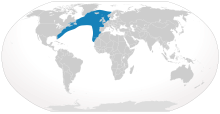Eubalaena glacialis
| North Atlantic right whale | |
|---|---|
 |
|
| Mother and calf | |
 |
|
| Size compared to an average human | |
| Scientific classification | |
| Kingdom: | Animalia |
| Phylum: | Chordata |
| Class: | Mammalia |
| Order: | Artiodactyla |
| Infraorder: | Cetacea |
| Family: | Balaenidae |
| Genus: | Eubalaena |
| Species: | E. glacialis |
| Binomial name | |
|
Eubalaena glacialis (Müller, 1776) |
|
 |
|
| Range map | |
| Synonyms | |
|
|
The North Atlantic right whale (Eubalaena glacialis, which means "good, or true, whale of the ice") is a baleen whale, one of three right whale species belonging to the genus Eubalaena, all of which were formerly classified as a single species. Because of their docile nature, their slow surface-skimming feeding behaviors, their tendencies to stay close to the coast, and their high blubber content (which makes them float when they are killed, and which produced high yields of whale oil), right whales were once a preferred target for whalers. At present, they are among the most endangered whales in the world, and they are protected under the U.S. Endangered Species Act and Marine Mammal Protection Act and Canada's Species at Risk Act. There are about 400 individuals in existence in the western North Atlantic Ocean – they migrate between feeding grounds in the Gulf of Maine and their winter calving areas off Georgia and Florida, an ocean area with heavy shipping traffic. In the eastern North Atlantic, on the other hand – with a total population reaching into the low teens at best – scientists believe that they may already be functionally extinct. Vessel strikes and entanglement in fixed fishing gear, which together account for nearly half of all North Atlantic right whale mortality since 1970, are their two greatest threats to recovery.
Like other right whales, the North Atlantic right whale, also known as the northern right whale or black right whale, is readily distinguished from other whales by the callosities on its head, a broad back without a dorsal fin, and a long arching mouth that begins above the eye. The body of the whale is very dark grey or black, occasionally with white patches on the belly. The right whale's callosities appear white due to large colonies of cyamids or whale lice.
...
Wikipedia

